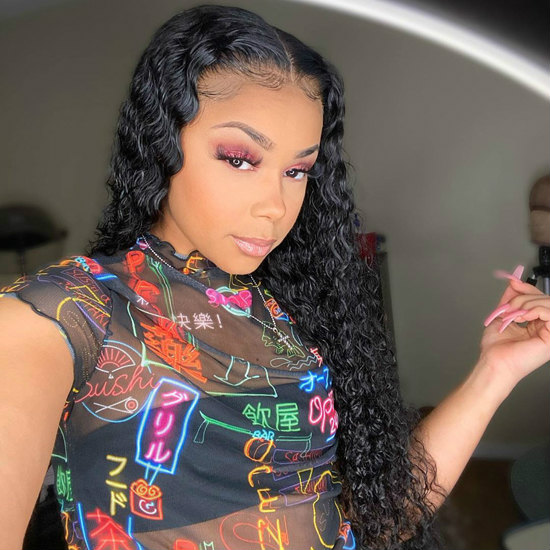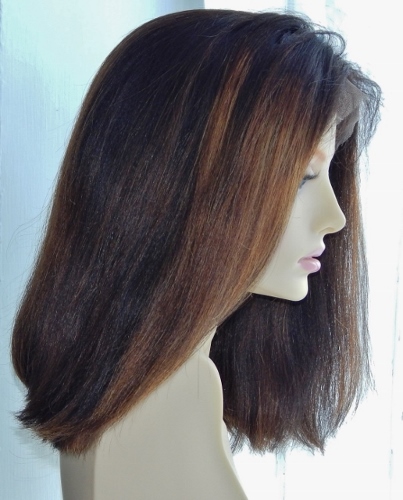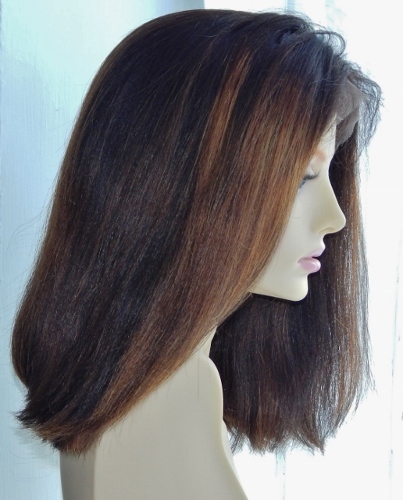If you’re looking to add texture to your human hair wig, you’re in luck! Human hair wigs are incredibly versatile and allow you to experiment with different styles and textures without any damage to your natural hair. With the ability to withstand heat styling and dyeing, owning a human hair wig is like having a blank canvas at your disposal, ready to be transformed into your perfect hairstyle. From straight to curly and coily, the natural textures of a human hair wig offer endless possibilities for creating the look you desire. So whether you’re looking to enhance your current hairstyle or completely change it up, adding texture to your human hair wig is easier than you may think. Adding texture to a human hair wig can completely transform its style and enhance its natural appearance. Whether you prefer loose curls, sleek texture, or wavy waves, there are several methods you can use to achieve the desired look. In this comprehensive article, we will guide you through the process of adding texture to your human hair wig, covering everything from washing and conditioning to styling with heat tools and using different curling methods. We will also explore the options of adding accessories, applying products, creating braids and twists, cutting and layering, dyeing the wig, and maintaining its texture. So let’s dive in and discover the best techniques for adding texture to your human hair wig!
Choosing the Right Texture
When it comes to adding texture to a human hair wig, the first step is to consider the look you desire. Do you want loose curls, sleek texture, or wavy waves? Determining your desired look will help you choose the right texture for your wig. Keep in mind that human hair wigs come in various textures, from straight to curly and coily. Take some time to research different texture options and find the one that matches your desired style.
Identifying the texture of your natural hair can also play a role in choosing the right texture for your wig. If you have naturally straight hair, you might want to opt for a straight or slightly wavy texture. If your natural hair is curly or coily, you might prefer a texture that matches your natural pattern or go for a different texture for a unique look. Remember, the goal is to achieve a seamless blend between your natural hair and the wig for a natural and harmonious appearance.
Washing and Conditioning
Before adding texture to your human hair wig, it is crucial to start with clean and moisturized hair. Start by using a gentle shampoo specifically formulated for human hair wigs. Avoid using harsh chemicals or products that could strip the hair of its natural oils. Gently massage the shampoo into the wig, focusing on the roots and avoiding excessive rubbing or tugging. Rinse thoroughly to remove any residue.
After shampooing, apply a moisturizing conditioner to restore hydration to the hair. Human hair wigs, just like natural hair, can become dry and brittle, so it’s essential to replenish moisture regularly. Use a wide-tooth comb or your fingers to distribute the conditioner evenly throughout the wig. Leave the conditioner in for the recommended amount of time, and then rinse it out thoroughly. This will leave your wig soft, smooth, and ready for the next step in adding texture.

Styling with Heat Tools
Heat styling is one of the most popular methods for adding texture to human hair wigs. To avoid heat damage and maintain the longevity of your wig, it’s essential to prep the hair with a heat protectant spray before using any heat tools. A heat protectant spray forms a protective barrier between the hair and the heat, minimizing the risk of heat-related damage.
If you desire loose curls, a curling iron is your best friend. Choose a barrel size that suits your desired curl size. Divide the wig into sections and start curling from the bottom, working your way up to the top. Hold each curl for a few seconds before releasing it for a long-lasting effect. Once all sections are curled, you can use your fingers or a wide-tooth comb to loosen the curls for a more natural and voluminous look.
For a sleek and straight texture, a straightener is the tool to use. Start by dividing the wig into small sections and slowly glide the straightener down each section from root to tip. Make sure to use a heat setting suitable for your wig’s texture to avoid excessive heat damage. For an extra sleek look, you can apply a small amount of hair serum or oil to add shine and reduce frizz.
Using Curling Methods
If you prefer not to use heat tools or want to achieve different types of curls, there are alternative methods for adding texture to your human hair wig. One option is to use flexi rods for bouncy curls. Flexi rods are flexible cylindrical rods that can be easily wrapped around the hair to create curls. Start by applying a curl-enhancing product or mousse to the wig, then wrap small sections of hair around the flexi rods. Leave the rods in overnight or use a hooded dryer to expedite the drying process. Once the hair is dry, carefully remove the flexi rods to reveal beautiful, bouncy curls.
Another curling method involves using perm rods for tighter curls. Perm rods are smaller and narrower compared to flexi rods, resulting in a tighter curl pattern. Apply a curl-enhancing product or mousse to the hair, then wrap small sections of hair around the perm rods. Allow the hair to dry completely before removing the rods. Once the rods are removed, you’ll have gorgeous, defined curls with a tighter texture.
If you prefer a wavy texture, you can twist the hair and use bobby pins to secure the twists. Start by dividing the wig into small sections and twist each section tightly. Use bobby pins to secure the twists in place. Leave the twists in overnight or until the hair is fully dry. Once the twists are removed, you’ll have beautiful, natural-looking waves. Run your fingers through the hair or use a wide-tooth comb to separate the waves for a more tousled and textured look.

Adding Accessories
Adding accessories to your human hair wig can elevate its style and enhance its overall appearance. Clip-in hair extensions are a popular choice for adding volume and length to the wig. Choose extensions that match the texture and color of your wig for a seamless blend. Section the wig and clip in the extensions where desired. You can strategically place the extensions to add volume at the crown or create face-framing layers for a more dynamic look.
Hair jewelry is another option for adding a decorative touch to your wig. From hairpins to charms and beads, there are countless options to choose from. Select jewelry that matches your personal style and complements the texture and color of your wig. You can place the jewelry throughout the wig or concentrate it in specific areas, such as the front or sides, for a unique and eye-catching look.
If you’re aiming for a boho vibe, try adding a headband to your wig. Headbands come in various styles, from thick and embellished to thin and simple. Choose a headband that complements the texture and color of your wig and matches your personal style. Simply place the headband around your head, positioning it wherever desired. You can wear the wig with the headband pushed back for a casual look, or wear it with the headband positioned near the hairline for a more polished appearance.
Applying Product
Using the right products can enhance the texture and hold of your human hair wig. A texturizing spray is a great option for adding definition and creating a more tousled look. Look for a spray specifically formulated for human hair wigs, as they are designed to provide texture without weighing the hair down. Spray the product onto the wig and scrunch with your fingers to enhance the texture and create a more lived-in look.
If you want a lightweight hold and added volume, consider applying a mousse to your wig. Choose a mousse that suits the texture and thickness of your wig. Apply a small amount to your hands and distribute it evenly throughout the wig, focusing on the roots for added lift and volume. Gently scrunch the hair with your fingers to activate the mousse and create texture and body.
To add moisture and maintain the health of your wig, consider using a leave-in conditioner. Leave-in conditioners are formulated to provide long-lasting hydration and nourishment to the hair. Apply a small amount to your hands and work it through the wig, making sure to distribute it evenly from root to tip. Leave the conditioner in and style as desired. The leave-in conditioner will keep the hair moisturized and help prevent dryness and brittleness.

Creating Braids and Twists
Braids and twists are versatile styling options that can add texture and dimension to your human hair wig. Braids can be used to create textured updos, while twists can add a sleek and intricate look. Comb through the wig to remove any tangles and divide it into sections, depending on the desired style.
If you’re opting for a textured updo, start by creating small braids in each section. You can choose from various braid styles, such as French braids, Dutch braids, or fishtail braids. Once all sections are braided, you can gather them together and secure them with bobby pins to create a textured updo. Pull out a few strands of hair around the face and loosen the braids slightly for a more bohemian and effortless look.
Twists are another great option for adding texture to your human hair wig. They can be done in various sizes and styles to achieve different looks. Separate the wig into small sections and twist each section tightly. Secure the twists with bobby pins or rubber bands to keep them in place. You can create a twist out style by leaving the twists in overnight and unraveling them in the morning. This will result in beautiful, defined curls with a textured appearance.
For a unique and creative texture, consider combining braids and twists in your wig. Section the hair and create a combination of braids and twists throughout the wig. You can experiment with different braiding and twisting techniques to create a one-of-a-kind look. This combination of textures will add depth and visual interest to your wig, making it stand out from the crowd.
Cutting and Layering
Cutting and layering your human hair wig can significantly impact its texture and overall style. While it’s always best to seek professional help for cutting, especially if you’re not experienced, there are some techniques you can try at home. Adding layers to your wig can create dimension and movement, enhancing its texture and giving it a more natural appearance.
Start by sectioning the wig and combing through the hair to remove any tangles. Take a small section of hair and hold it between your fingers at the desired length. Use sharp hairdressing scissors to make a clean and precise cut. Repeat this process throughout the wig, focusing on layers that frame your face and add volume to the crown. Remember to take it slow and trim small sections at a time to avoid cutting too much.
Experimenting with different cutting techniques can also add texture to your human hair wig. Point cutting, where the scissors are held perpendicular to the hair and small random cuts are made, can create a textured and softening effect. Slide cutting, where the scissors are held at an angle and small cuts are made throughout the section, can create movement and texture. These techniques can be used in combination with layering to achieve the desired texture and style.
Dyeing the Wig
Dyeing a human hair wig can be a great way to add texture and change its overall look. However, it’s crucial to research dyeing methods for human hair wigs and understand the potential risks involved. If you’re not confident in dyeing the wig yourself, it’s best to seek professional dyeing services to ensure a safe and desired outcome.
If you decide to dye the wig yourself, consider using temporary hair color for a non-permanent change. Temporary hair color can be applied to the wig and easily washed out, allowing you to experiment with different colors without any long-term commitment. Remember to choose a hair dye specifically formulated for human hair wigs and follow the instructions carefully to achieve the desired texture and color.
Before dyeing the wig, it’s essential to prepare the hair and protect it from potential damage. Start by brushing the wig gently with a wide-tooth comb to remove any tangles. Apply a protective oil or cream to the hairline and parting to prevent staining. Depending on the dyeing method you choose, you may need to pre-lighten the hair or apply a color directly. Follow the instructions provided with the dye and take your time to achieve an even and desired result. Once the dyeing process is complete, rinse the wig thoroughly and apply a hydrating conditioner to restore moisture and maintain the health of the hair.
Maintaining the Texture
After adding texture to your human hair wig, it’s essential to maintain its appearance and prolong its lifespan. Proper maintenance and care will ensure that the texture stays intact and the wig remains in excellent condition for a long time.
To keep the texture looking its best, brush the wig gently with a wide-tooth comb or a wig brush designed specifically for human hair wigs. Start at the ends and work your way up to the roots, being careful not to tug or pull on the hair. Avoid using a brush with fine bristles, as it can cause the hair to break or frizz.
Excessive heat styling can damage the hair and alter the texture. To prevent damage, avoid using heat tools frequently and use them only when necessary. If you do use heat tools, make sure to apply a heat protectant spray beforehand to minimize the risk of heat-related damage. It’s also a good idea to use a lower heat setting to avoid excessive heat exposure.
Proper storage is crucial to maintaining the texture of your human hair wig. Store the wig in a dry and cool place, away from direct sunlight and excessive humidity. Consider using a wig stand or mannequin head to store the wig, as this will help preserve its shape and prevent the hair from tangling or matting. If you need to travel with the wig, use a wig box or a storage bag specifically designed for wigs to protect it from damage.
In conclusion, adding texture to a human hair wig can open up a world of possibilities for creating unique and personalized hairstyles. Whether you choose to use heat tools, curling methods, or accessories, the key is to consider your desired look, research different texture options, and choose the methods that suit your personal style and preference. Remember to take proper care of your wig by washing and conditioning it regularly, using the right products, and maintaining the texture through gentle brushing and proper storage. With these tips and techniques, you can achieve the perfect texture for your human hair wig and explore endless hairstyle possibilities with confidence and style.

